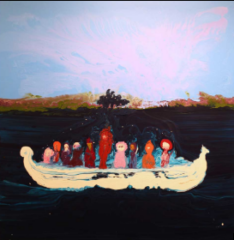
Among the top 5 sellers at Sotheby’s New York Impressionist & Modern Art Evening Sale on May 14, 2018 was a painting by American artist Georgia O’Keeffe (1887-1986). Lake George with White Birch reached $11.29 million dollars, performing over nearly twice its high estimate.


This is O’Keeffe’s third-highest price after Lake George Reflection (1921-1922) reaching $13M at Christie’s New York in 2016 and Jimson Weed White Flower No 1 (1932) skyrocketing at $44.4M at Sotheby’s New York in 2014, setting a record for an artwork by a female artist. This floral painting which once hung in George W. Bush’s dining room had fetched more than three times its auction estimate of $10M-$15M. Elizabeth Goldberg, Sotheby’s head of American painting, said the landmark sale “places Georgia O’Keeffe’s work in the top tier of 20th-centuryartists on the market internationally, where it has always belonged.”Although $44.4M is a hefty price tag, some art historians and critics point out that it is so much less than the most expensive paintings by male artists. In fact, at the May 14, 2018 auction, a large nude by Modigliani sold for $157.2 million, becoming the fourth most expensive work of art ever sold. In comparison, Leonardo da Vinci’s Salvator Mundi (Savior of the World) was bought for $450 million in New York in November 2017, shattering the record for the most expensive artwork ever sold despite lingering doubts over its authenticity. It is important to place O’Keeffe’s work in the context of the overall American art market which has consistently performed high despite some challenges faced in the 2008-2011 period.

The sale of American art is dictated by the stature of the artist, the period in which he/she is working, the work’s subject matter, and the rarity or context within the artist’s oeuvre. O’Keeffe, who died in 1986 at the age of 98, is widely considered as one of the greatest 20th century American painters. She was celebrated for her large-format depictions of flowers which she painted as if they had been seen close-up. Her floral images stand among the most recognizable images in both art history and popular culture. Over the last ten years, the market for O’Keeffe has remained steady and strong, as demonstrated by the sale of a fair amount of oil pieces reaching the $4 million range with the majority of them performing regularly above the one-million-dollar mark. The recent sale of Hibiscus (shown at left) at $4.8M at Christie’s American art auction on May 22, 2018 in New York confirms that trend.

Recently handled by Veritas Fine Art for the Rahr-West Museum, in Manitowoc, Wisconsin, Birch and Pine Trees II (1925) is a fine example of O’Keeffe’s art and fits into a series of trees she painted over the course of several years when she and her husband photographer Alfred Stieglitz vacationed in the family’s second residence by Lake George in upstate New York from 981 to about 1929. During that time, O’Keeffe began a diverse series of paintings relating to the lake and her impressions of the surrounding natural landscape. It was an inspiring landscape for O’Keeffe, with its vast panorama allowing her to experiment with color and form, and place between abstraction and representation. There, she often took long walks and marveled at the beauty of the scenery: “there is something so perfect about the mountains and the lake and the trees…it is really lovely,” she wrote to her friend and author Sherwood Anderson.
Recently handled by Veritas Fine Art Appraisals, Georgia O’Keeffe’s Birch & Pine Trees II, 1925, oil on canvas, 36 in. H x 22 in W. From the permanent collection of the Rahr-West Museum in Manitowoc, Wisconsin.
Provenance: Estate of the artist, 1986 (Michael Lord Gallery, Milwaukee, Wisconsin). Mrs. John D. est, Manitowoc, Wisconsin, 1990.
Exhibition History: 1948 New York (MOMA – Alfred Stieglitz)With Birch and Pine Trees II, O’Keeffe presents a stylized and sweeping composition of trunks, branches and foliage, a celebration of the colorful effects of Lake George in October and of nature’s vitality, an important theme for O’Keeffe. This kind of composition resembles her signature motif of the close-up flowers where the petals and blooms are highly abstracted into sweeping shapes and large surfaces of colors. In this piece, the magnified depiction of the abstracted trunk and foliage combined with the unified palette of white, green and reddish browns emphasize the flat surface of the canvas. O’Keeffe, like many modernist painters, exploited that flatness of the canvas and did not seek to impose on it an illusion of depth.
I will conclude with this celebratory homage to the artist printed in the Chicago Evening Post in 1926, by the journalist Blanche Matthias: “She is like the flickering flame of a candle, steady, serene, softly brilliant…this woman who lives fearlessly, reasons logically ,who is modest, unassertive, and spiritually beautiful, and who, because she dares paint as she feels, has become not only one of the most magical artists of our time, but one of the most stimulatingly powerful.”
– Rachel Christophe Baker,
Fine Art Appraiser,
Veritas Fine Art Appraisals & Consulting Group






